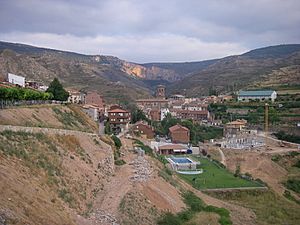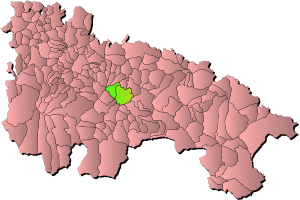Viguera facts for kids
Quick facts for kids
Viguera
|
||
|---|---|---|
 |
||
|
||
 |
||
| Country | ||
| Autonomous Community | ||
| Region | Rioja Media | |
| Comarca | Camero Nuevo | |
| Area | ||
| • Total | 41.72 km2 (16.11 sq mi) | |
| Elevation | 689 m (2,260 ft) | |
| Population
(2018)
|
||
| • Total | 390 | |
| • Density | 9.35/km2 (24.21/sq mi) | |
| Demonym(s) | viguereño / a | |
Viguera is a small town, also called a municipality, located in a beautiful region of La Rioja, Spain. It's a place with a long history, nestled among hills and valleys. Viguera includes a few smaller villages like Castañares de las Cuevas, El Puente, and Panzares.
Contents
History of Viguera
The story of Viguera goes way back! The first written records about it come from a historian from the Berber people. He wrote that in 759, a ruler named Abd ar-Rahman I took back the area of La Rioja. This happened after another ruler, Alfonso I of Asturias, had conquered it in 755. The historian specifically mentioned that after capturing Viguera Castle, Abd ar-Rahman I traveled through all of La Rioja.
Viguera as a Fortress
Viguera was an important fortress. It was used by a powerful family called the Banu Qasi to protect La Rioja from Christian armies.
In the late 800s, a man named Lubb ibn Musa, who was a son of the famous Musa ibn Musa al-Qasawi, rebuilt the fortress. Sadly, Lubb died while hunting deer and was buried right there.
The Kingdom of Viguera
When Christian forces slowly took back control of the land, Viguera became the center of its own kingdom! This was called the Kingdom of Viguera and it lasted from 970 to 1005. After this time, Viguera became part of the Kingdom of Navarre. Later, the area was given to noble families from Cameros, who ruled it as part of their lands.
Population and Villages
Viguera is a small community today. The number of people living here has changed a lot over the years. This table shows how the population has grown and shrunk since 1900.
| Historical population | ||||||||||||||||||||||||||||||||||||||||
|---|---|---|---|---|---|---|---|---|---|---|---|---|---|---|---|---|---|---|---|---|---|---|---|---|---|---|---|---|---|---|---|---|---|---|---|---|---|---|---|---|
|
|
|||||||||||||||||||||||||||||||||||||||
| Source: Instituto Nacional de Estadística de España | ||||||||||||||||||||||||||||||||||||||||
Villages in Viguera
The municipality of Viguera includes a few smaller villages:
- Viguera (the main town)
- Castañares de las Cuevas
- El Puente
- Panzares
Places to Visit
Viguera has many interesting old buildings and places to explore, showing its long history.
- Parish Church of La Asunción: This church was built in the 1500s using strong stone. It has been carefully fixed up recently.
- Hermitage of Nuestra Señora del Rosario: A hermitage is a small church or chapel. This one was built in the 1500s and then changed in the 1700s.
- Hermitage of San Marcos: This hermitage is from the 1600s. It was recently restored by a group of women from the town who wanted to help, even if they weren't directly involved in its festivals.
- Hermitage of San Esteban
- Hermitage of Santa Lucía: Located in the village of Panzares, this hermitage was rebuilt in 1968. It stands on the spot of an older building from the 1500s.
- Parish Church of La Asunción in Castañares de las Cuevas: This church in the village of Castañares de las Cuevas also dates back to the 1500s.
Medieval Bridges
Viguera is also home to some very old bridges:
- One bridge is near the border of Viguera, leaving towards Logroño. It was built in the 1000s!
- Another old bridge is found after the town of Islallan.
Local Festivals
The people of Viguera love to celebrate! They have a few special festivals each year:
- Saint Mark's Day: Celebrated on April 25.
- Patron Saint Festivals: These big celebrations honor Saint James and Saint Ann on July 25 and 26.
See also
 In Spanish: Viguera para niños
In Spanish: Viguera para niños





